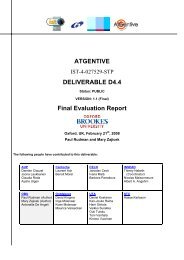pdf 820Kb - INSEAD CALT
pdf 820Kb - INSEAD CALT
pdf 820Kb - INSEAD CALT
Create successful ePaper yourself
Turn your PDF publications into a flip-book with our unique Google optimized e-Paper software.
Evaluation report of the use of Onto-Logging<br />
platform in the user site<br />
Deliverable ID: D8b<br />
Page : 58 of 110<br />
Version: 1.0<br />
Date: 27 january 2004<br />
Status: Final<br />
Confid.: Public<br />
the users would need, or which concepts may be interesting for them. These allow us to add<br />
those concept missed in the original ontology.<br />
Once a first draft of the new ontology has been sketched, it is better to work directly with the<br />
Ontologging system tools, which provide a richer environment to redesign ontologies, even if<br />
the new ontology is not totally defined.<br />
Step 2 – From paper to Ontologging: ‘rough’ migration<br />
The ‘sketched’ ontology was transferred to the system using KAON. The original ontology<br />
was used as a reference, since some of the concepts were the same.<br />
Once the first version was introduced in the system with KAON, the next task was defining<br />
the mappings or translations required to move the already existing data from the original<br />
ontology to the new one. This process was ma de using the ORA (Ontologging Reconciliation<br />
Agent), programming in XML the required mappings.<br />
This tool allowed avoiding the loss of a huge amount of data, already introduced in the<br />
original ontology. However, this migration process does not allow to map all the instances to<br />
their corresponding concept, because when a concept from the original ontology is mapped to<br />
different concepts in the new ontology, it may be difficult to establish a way to distinguish<br />
the to which concept the instances must be assigned. Therefore, it will be necessary an<br />
additional work to separate this instances in a later stage.<br />
Step 3 – Polishing the ontology – ‘sharp’ migration<br />
Although ORA allowed moving an important amount of data, the result still required some<br />
additional work of adjustment and tuning. The DUI was used at this stage for completing the<br />
work. The DUI was used:<br />
• To check if its design is correct from the point of view of the final users<br />
• To complete the data population with some instances that were not present in the original<br />
Ontology. Indeed the new Ontology had also introduced new concepts and new relations,<br />
for which associated instances and relationships had to be created.<br />
At this final stage, the work was an iterative cycle between KAON (the Ontology editor) the<br />
DUI, and sometime the ORA (with was used to move some data not included in the ‘gross’<br />
migration).<br />
Following is the iteration cycle:
















